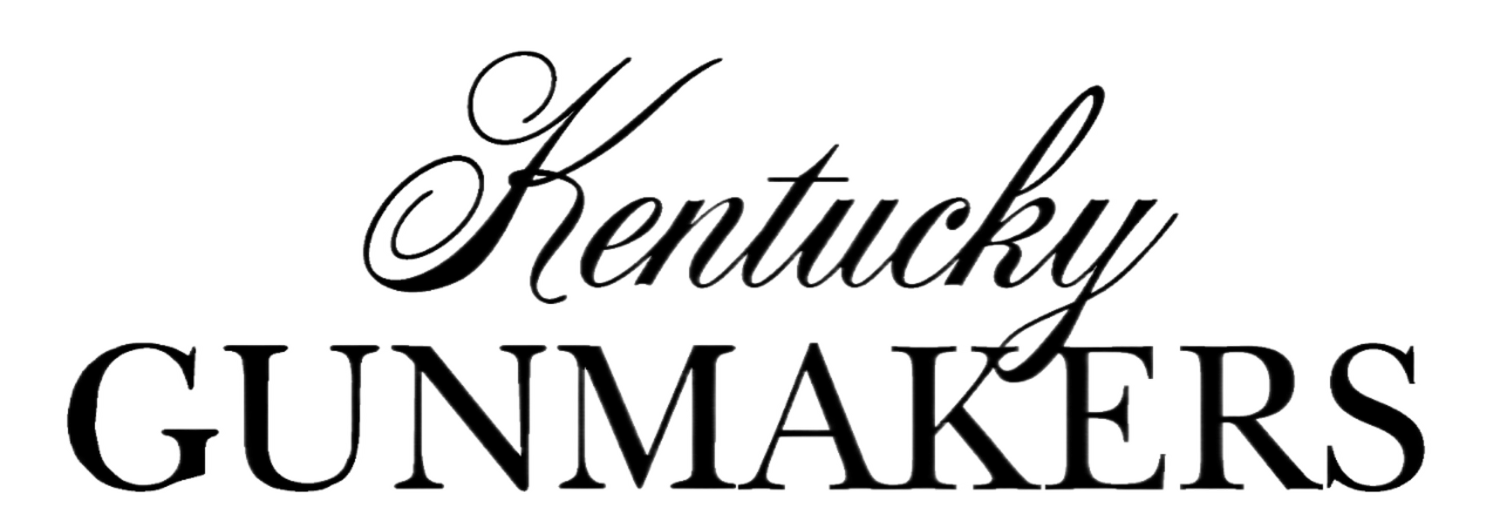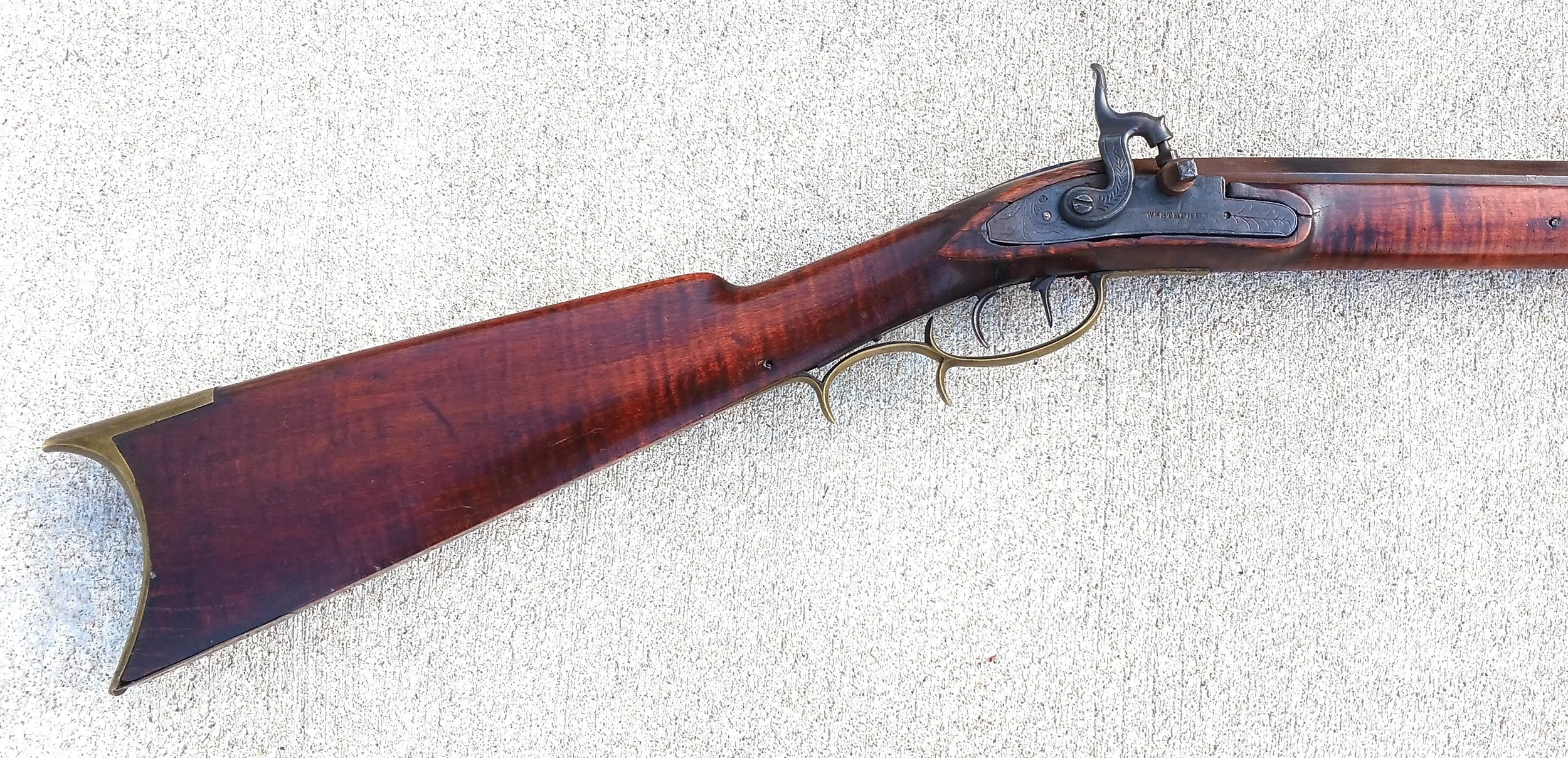William Stephens’ Rifle puts Butler County into the Barrens School ©
Foreword: The Barrens School covers about a dozen counties in south-central Kentucky, most of which border on Tennessee. The school is known for well-made but undecorated rifles of superior accuracy and durability. Prior blog articles have featured Barrens School rifles by Settle, West, and Heath gunsmiths, all working in the southern tier of the Barrens School [1]. Recently a rare example of a northern tier rifle by William Stephens of Butler County, Kentucky, sold at auction. The rifle is shown in Figure No.1 and follows the pattern of Barren School rifles… good quality guns that lack decoration. The discovery of the Stephens rifle puts Butler County solidly into the Barrens School of gunmaking.
Figure No.1: The “Wm Stephens” signed rifle is nicely stocked in curly maple with Kentucky features that include double spurred guard with oval bow, triangular butt, and rectangular extension coming off the percussion drum or side lug. The gun follows the pattern of most Barrens School rifles with its quality stocking that lacks decorative details such as inlays, engraving, molding lines, and carving. Even the location of the rear sight, a few inches behind the rear ramrod pipe instead of directly over it, is typical of most Barrens School rifles. The Stephens rifle verifies that Butler County guns are stylistically part of the Barrens School of gunmaking. Barrel: 41-1/2 inches long with .40 caliber bore. Author’s collection, photos by Author.
William Stephens: Stephens was a trained English gunsmith, born in 1797, who left England for America in 1828 to work for gunmaker Joseph Henry of Pennsylvania. Stephens was hired to make high quality rollered flintlocks for Henry’s better guns. He returned to England briefly in 1846 to bring his sons William Jr. and John back to America. Stephens then settled in Brown County, Ohio, on the Ohio River across from Kentucky. About 1850 he moved to Butler County, Kentucky, on the northern fringe of the Barren School, where he opened a gun shop in Reedyville assisted by his sons. The shop was closed during the Civil War when the sons left to serve in the Confederate Army as gunsmiths. After the war the sons returned and reopened the shop, but William Stephens, Sr. remained retired from gunsmithing on his 150-acre farm near Reedyville, where he died in 1870. The sons ran the Stephens gun shop until 1885 when it was closed permanently.
Figure No.2: The William Stephens rifle is signed twice on both the barrel and lock plate with the same stamp. The slightly worn “s” at the end of the name stamp is identical to another stamped half-stocked Stephens rifle, but here the stamp is a little sharper since the full-stocked gun is earlier. Author’s collection, photo by Author.
The “Wm Stephens” Rifle: The author has seen only two signed William Stephens rifles, a later half-stocked rifle with back-action lock [2], and the full-stocked rifle shown here. Both rifles were well-made with fine wood-to-metal fit and typical Kentucky architecture with triangular butts and slender stocking. Both guns were identically stamped “Wm Stephens.” The earlier full-stocked rifle in Fig. No.2 is stocked in curly maple with a slender butt and oval cheekpiece shown in Figures No.3 and No.4 that suggest a circa 1850 percussion rifle. Kentucky details include: 1) longer two-screw tang; 2) fine triggers; 3) nicely oval opening in the guard’s bow; 4) side facings pointed at the rear but tight around the front of the lock plate; 5) a square extension coming off the percussion drum to assist its removal. Despite the gun being made on the northern fringe of the Barrens School, it follows the school’s tradition of being well-made but plain. There are no inlays, molding lines, or carving on the gun. Instead, good stock architecture and wood combine to create an attractive rifle without embellishments.
Figure No.3: The Stephens rifle has Kentucky’s typical triangular butt and nice ovality in the guard’s bow. While hard to see here, the lock is stamped “Wm Stephens” similar to the barrel.
Figure No.4: The back side of the rifle has a neatly shaped later style oval or “beaver tail” cheekpiece and small brass lock bolt washer. Stephens’ side facings were pointed at the rear and rounded in front.
Rifle’s Significance: Kentucky’s Barrens School of gunmaking covered a large area of southcentral Kentucky, much like the large Mountain Rifle School in southeastern Kentucky. Each school’s guns had details common to that school, but they also exhibited more variation than Kentucky’s smaller, more distinctive schools such as Bardstown and Lexington. Bordering counties around the larger schools are not considered part of those schools until rifles are found that document their design similarities to the nearby school, allowing the “new” county to be moved into the school. When a new rifle helps link a border county to a nearby school, such guns are significant discoveries. The William Stephens rifle is such a rifle, linking Butler County to the Barrens School where rifles were well-made but lacked the decorative details often seen on central Kentucky guns.
Summary: The “Wm. Stephens” rifle verifies that Barrens School style rifles of good quality but minimal decoration were being made in Butler County on the northern edge of the Barrens School, allowing Butler County to be included within the Barrens School. The rifle also shows how a well-trained English gunsmith, initially known for his ability to make high quality gun locks, could evolve and become a traditional Kentucky gunsmith making guns that followed local preferences, in this case the good quality/no decoration pattern of the Barrens School in southcentral Kentucky.
Sources:
1. Blog Articles:
“Kentucky’s Finest Rifle from its Western Barrens Region”
“Settle Rifles from Kentucky’s Barrens School: An Example by Felix Settle”
“Kentucky’s Heath Family and Their Tennessee Style Rifles”
2. Kentucky Gunmakers 1775-1900, Epilogue, Figures 6-6, p.123.




